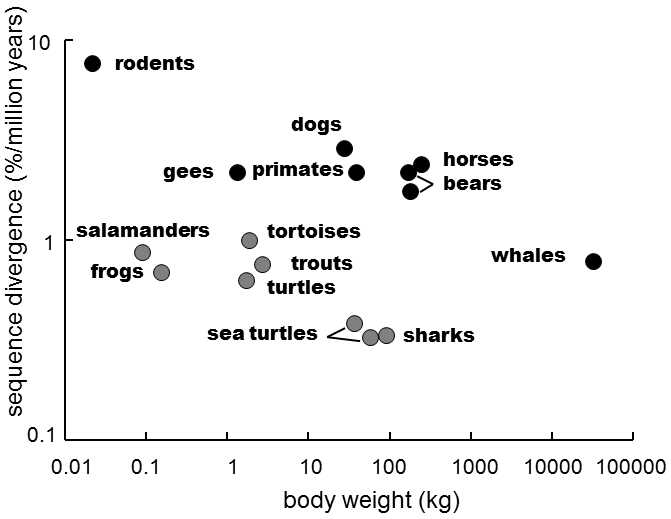IX.4.4.2 The substitution rate correlates with both the size of animals and their metabolic rate
The substitution rate is numerically equal to the mutation rate (see IX.2).This means that species with higher mutation rates should also have a proportionally increased substitution rate.The species-characteristic mutation rate depends on a number of factors, including the intensity of metabolism, i.e. the rate of metabolism related to one gram of body weight.For example, a great many metabolic reactions entail the formation of free radicals, which can damage the DNA and thus induce mutations.In general, it can be assumed that species with smaller body dimensions will have greater metabolic intensity than large species and also that homoiothermal (warm-blooded) species will have higher mutation rates than poikilothermal (cold-blooded) species.It has actually been observed that the substitution rate calculated on the basis of sequence divergence is higher for homoiothermal species than for poikilothermal species.Simultaneously, the expected negative correlation has been observed between the substitution rate and the average body size of the members of the individual species (Fig. IX.12)(Martin & Palumbi 1993). However, it is not entirely certain whether the cause of the correlation between the body size and

Fig. IX.12. Negative correlation between the body weight of an animal and the substitution rate in mitochondrial DNA. It is apparent from the graph that species of homoiothermal (warm-blooded) vertebrates (dark points) exhibit, on an average, greater substitution rate than poikilothermal species of vertebrates of the same weight (light points) and that the substitution rate is negatively correlated with the body weight. Modified according to Martin and Palumbi (1993).
the substitution rate actually lies in the effect of the intensity of metabolism on the mutation rate.At an interspecies level, there is usually a very close relationship between body weight and the generation time.Large species generally have a proportionately longer generation time, where the length of the generation time should have a similar effect on the substitution rate of neutral mutations as the body weight.Detailed statistical analysis performed on primates has, however, indicated that the generation time apparently has a smaller effect than the intensity of metabolism on the substitution rate of neutral mutations (Martin & Palumbi 1993)
